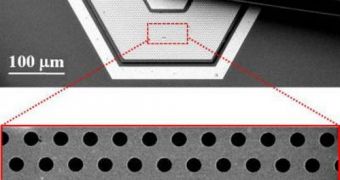Taking a quantum dot-based infrared detector as a starting point, a group of American researchers managed to produce a new, advanced microlens that can boost the strength of an infrared signal. The main accomplishment here is that this is done with a nanoscale device that does not increase the noise (scrambled, unwanted data) of the signal as well. The science group, based at the Rensselaer Polytechnic Institute (RPI), basically created a lens-less microlens, that harness the peculiar behavior that gold exhibits at the nanoscale to create the amplification effect.
The innovation could be used for a wide variety of applications, such as improving existing night-vision technologies, or for creating a new generation of high-tech infrared satellites for space exploration. The new study was only made possible by the fact that physics takes on a new face when brought down to the nanoscale. Particles begin behaving awkwardly, and harnessing these bizarre traits can lead to advancements that would change our technology. What the gold does in this new set-up is basically “squeeze” light into tiny holes on the surface of the device, which apparently increases its sensitivity considerably.
“Infrared detection is a big priority right now, as more effective infrared satellite imaging technology holds the potential to benefit everything from homeland security to monitoring climate change and deforestation. We have shown that you can use nanoscopic gold to focus the light entering an infrared detector, which in turn enhances the absorption of photons and also enhances the capacity of the embedded quantum dots to convert those photons into electrons. This kind of behavior has never been seen before,” explains RPI Future Chips Constellation and Smart Lighting Engineering Research Center member Shawn-Yu Lin. He is also a professor of physics at the Institute, and the leader of the new research initiative.
The investigation was funded mainly by the US Air Force (USAF) Office of Scientific Research. The full details are published in a paper entitled “A Surface Plasmon Enhanced Infrared Photodetector Based on InAs Quantum Dots,”, which appears in the latest online issue of the highly-regarded scientific journal Nano Letters. “I think that, within a few years, we will be able to create a gold-based QDIP (quantum dot infrared photodetectors) device with a 20-fold enhancement in signal from what we have today. It's a very reasonable goal, and could open up a whole new range of applications from better night-vision goggles for soldiers to more accurate medical imaging devices,” Lin concludes.

 14 DAY TRIAL //
14 DAY TRIAL //